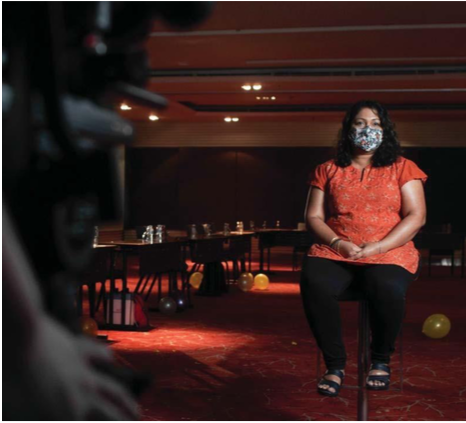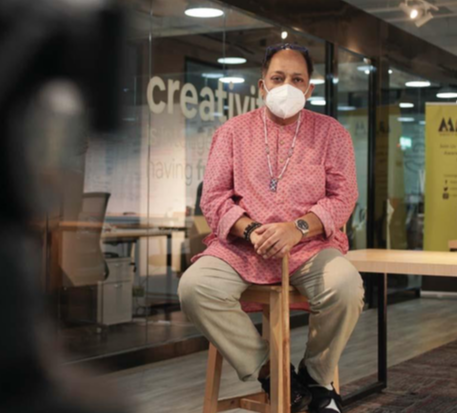WHO Project Documentation
in collaboration with Blink NYC

The global pandemic highlighted the critical need for accessible health information, especially for vulnerable populations. In response to this, the Make It Right Movement (MIRM), in collaboration with Blink NYC, undertook an important initiative to bridge the gap in communication. This project, requested by the World Health Organisation (WHO), focused on providing essential COVID-19 resources such as videos, posters and infographics—to marginalised communities across Malaysia, helping them understand and respond to the pandemic more effectively.
The Challenge: Communicating COVID-19 Information to Diverse Communities
When the COVID-19 pandemic struck, one of the greatest challenges was ensuring that accurate information about the virus, vaccinations and safety protocols reached every corner of society. Vulnerable groups, particularly those with language barriers or limited access to technology, were at a higher risk of being left uninformed. For many in these communities, there were significant obstacles to understanding important health advisories due to a lack of accessible resources tailored to their needs.
Recognising this gap, WHO partnered with MIRM and Blink NYC to document the impact of COVID-19 on Malaysia's most vulnerable populations and provide targeted support through accessible and culturally relevant materials. The project was designed to ensure that everyone, regardless of their language, background or circumstances, could access life-saving information.
MIRM’s Role: Delivering Health Information to Vulnerable Groups
As an organisation deeply embedded in community work, MIRM played a pivotal role in connecting these vulnerable communities with the necessary health information. MIRM’s extensive network, built through its work with marginalised groups, positioned it perfectly to deliver this initiative. The project focused on producing and distributing resources in multiple languages and formats that catered to specific community needs.
The resources created through this collaboration included:
Educational Videos: Short, simple videos were produced to explain critical aspects of COVID-19, including symptoms, preventative measures and the vaccination process. These videos were made available in multiple languages, ensuring that they could be understood by non-Malay speaking communities, such as the Tamil and Mandarin-speaking populations.
Posters and Infographics: Visual aids were created to clearly communicate key information about COVID-19. These materials used minimal text and relied on strong visuals to convey messages, making them accessible even to those with low literacy levels.
Infographics on Vaccination: One of the key focuses of the project was promoting vaccination. The materials explained how to register for vaccines, what to expect during the vaccination process and the potential side effects to monitor after getting vaccinated.
Addressing the Needs of Different Language Communities
One of the main aspects of the project was its emphasis on addressing the needs of different language communities across Malaysia. MIRM ensured that the COVID-19 resources were translated into multiple languages and dialects, including Tamil, Mandarin and indigenous languages. This was especially important in rural and underserved areas, where many community members had limited proficiency in Bahasa Malaysia or English.
By making the information available in languages that these communities understood, MIRM and Blink NYC empowered individuals to take control of their health and make informed decisions during the pandemic. The project’s materials also highlighted the importance of recognising symptoms, maintaining hygiene practices and following public health guidelines.
The Impact: Empowering Communities Through Information
The collaboration between MIRM, WHO and Blink NYC had a profound impact on communities that were previously underserved in terms of health information. As COVID-19 swept through Malaysia, many people from marginalised groups, including migrant workers, indigenous communities and refugees, were unsure how to protect themselves or where to go for help. The timely dissemination of accessible information through the project ensured that these communities were better equipped to respond to the pandemic.
By connecting these groups with critical health resources, the project helped reduce anxiety and confusion around COVID-19. Additionally, the materials provided guidance on how to navigate government services, such as registering for vaccinations and seeking medical care. This was crucial in helping vulnerable populations access vaccines and other essential healthcare services, thereby reducing the spread of the virus within these communities.
Collaborating with Blink NYC and WHO
The partnership with Blink NYC, a creative agency known for its innovative media campaigns, ensured that the materials produced were not only informative but also engaging and easy to understand. Blink NYC’s expertise in crafting effective communication materials played a key role in ensuring the success of the project.
Together with WHO’s guidance on public health information and MIRM’s deep understanding of community needs, this collaboration resulted in a comprehensive communication strategy that reached far beyond mainstream media channels. The project documented how MIRM connected communities with health resources, effectively creating a blueprint for delivering critical health information during a global crisis.
Looking Ahead: A Model for Future Health Crises
The success of this initiative underscores the importance of making health information accessible to all, particularly in times of crisis. As the world continues to grapple with the aftershocks of the pandemic, MIRM’s work with Blink NYC and WHO provides a valuable model for future health emergencies. By prioritizing vulnerable communities and tailoring communication to their specific needs, organizations can ensure that no one is left behind in receiving life-saving information.
Moving forward, MIRM plans to continue working with WHO and other partners to expand its efforts in health communication and community engagement, focusing on ensuring that marginalized groups have ongoing access to the resources they need.
The collaboration between MIRM, WHO and Blink NYC on the COVID-19 project documentation is a powerful example of how organisations can come together to address global challenges on a local scale. By providing accessible, culturally sensitive information, MIRM ensured that even the most vulnerable members of society had the knowledge they needed to protect themselves during the pandemic.
Through this initiative, MIRM reaffirmed its commitment to enriching communities and transforming lives—principles that will continue to guide its work in the years to come.

